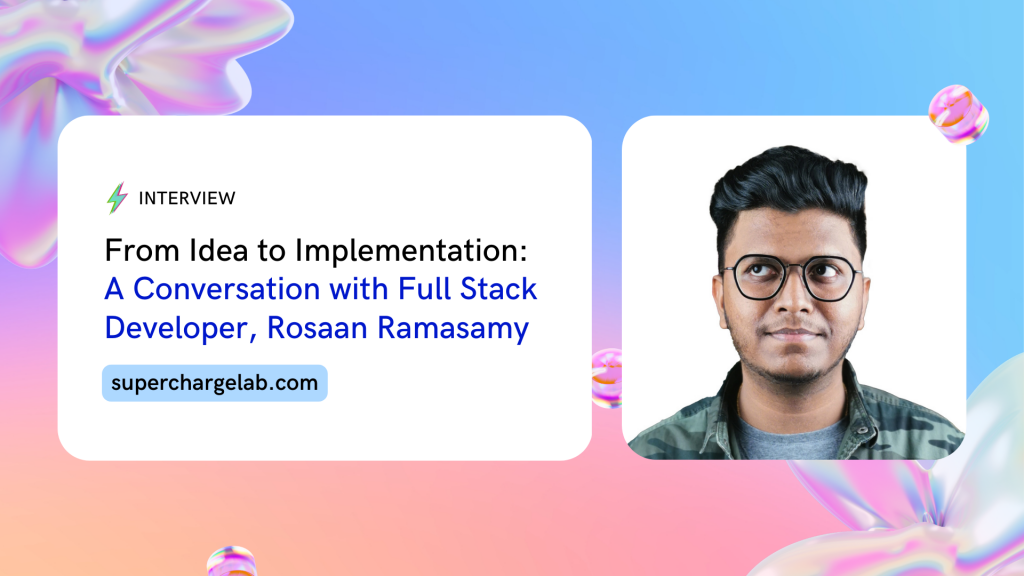
As the world becomes increasingly digitized, the demand for talented Full Stack Developers continues to grow. This month, we sat down with Rosaan to talk about his journey into tech, the challenges he has faced, and how he builds cutting-edge software solutions in Supercharge Lab.
What is your approach to writing clean, maintainable, and scalable code? Are there any particular coding standards or practices that you follow?
My approach to writing clean, maintainable, and scalable code involves following best practices and adhering to established coding standards. I use the SOLID principles as a foundation and focus on writing modular, reusable components. I follow the DRY (Don’t Repeat Yourself) principle and keep code as simple as possible (KISS principle). I make use of version control systems like Git, which aids in collaboration and code maintainability. For TypeScript and JavaScript, I utilize tools like ESLint and Prettier to enforce consistent coding styles and identify potential issues.
How do you prioritize and manage your workload when faced with multiple projects and deadlines? Can you walk us through your process for managing project timelines and ensuring timely delivery?
To prioritize and manage my workload when faced with multiple projects and deadlines, I use a combination of time management and project management techniques. I usually start by breaking down each project into smaller, manageable tasks, then prioritize these tasks based on their urgency and importance. I create a timeline for each project and set milestones to track progress. I use tools like Trello or Jira for task management and communication with team members. To ensure timely delivery, I conduct regular check-ins and adjust the plan as necessary to accommodate changes in priorities or resources.
As a full-stack developer, you’ll be working on both the front-end and back-end of web applications. How do you strike a balance between ensuring a great user experience and maintaining optimal performance and security?
Striking a balance between ensuring a great user experience and maintaining optimal performance and security requires a solid understanding of both front-end and back-end technologies. On the front-end, I focus on responsive design, accessibility, and performance optimization to provide a seamless user experience. On the back-end, I ensure that the code is efficient, secure, and scalable by following best practices like input validation, proper error handling, and using caching mechanisms. I also utilize tools like performance profilers and security analyzers to identify and address potential bottlenecks and vulnerabilities.
Can you tell us about a particularly complex problem you solved as a full-stack developer? How did you approach the problem, and what tools or technologies did you use to solve it?
One particularly complex problem I faced was the development of a real-time data visualization platform for a large-scale IoT project. The platform needed to handle a massive amount of incoming data while providing a smooth and responsive user interface. To address this challenge, I designed a modular architecture with microservices on the back-end, using Elixir for its concurrency capabilities. I used Node.js and WebSockets to handle real-time communication between the server and the front-end, which was built using React and D3.js for data visualization. By optimizing both front-end and back-end components, I was able to deliver a solution that met the client’s requirements for performance and scalability.
At Supercharge Lab, we value continuous learning and growth. How do you approach improving your skills and staying on top of emerging technologies in your field?
Continuous learning and growth are essential in the rapidly evolving field of web development. I stay up-to-date with emerging technologies and industry trends by following relevant blogs, attending webinars, and participating in online communities like Stack Overflow and GitHub. I set aside time to explore new tools and frameworks, and I’m not afraid to experiment with them in personal projects or side projects at work. Additionally, I find attending conferences and meetups to be valuable for networking and learning from other professionals in the field. By staying proactive and committed to learning, I can ensure that I remain at the forefront of technological advancements and continue to provide high-quality solutions to clients.